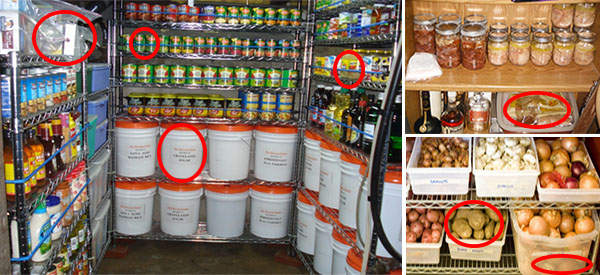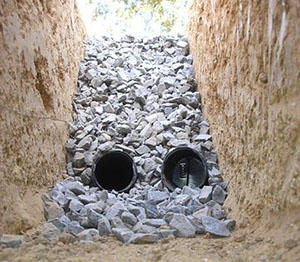How do You Keep Your Pantry Dry to Prevent Your Food from Spoiling?

by CURTIS LEE
Whether you’re storing food to save money, prepare for a major disaster or simply enjoy the art of food preservation, avoiding food spoilage is always a challenge. In many situations, the best way to make food as long as possible is to keep it dry. But what are some ways to keep your pantry or other food storage location from getting wet?
Identify the Source of Moisture
If you’ve properly prepared your food for storage, any excess moisture that might spoil your food will come from sources other than the food itself. To effectively combat any extra moisture in your pantry, you’ll need to figure out where it’s coming from.
Most pantries will be located at or below ground level. This means the source of water will probably stem from outside your dwelling, such as ground or surface water flowing during precipitation or another natural occurrence. But this may not always be the case. There might also be moisture in the air in the form of humidity.
=> How to build your rootcellar for less than $400 (video)
Therefore, before you take any steps to keep your pantry dry, you’ll need to figure out where your water is coming from. You can do this by taping a roughly 1’ x 1’ sheet of aluminum foil onto the wall of your pantry. After waiting a few days, partially peel away the aluminum foil. Examine both sides of the sheet of aluminum foil for any signs of moisture buildup or condensation.
If you see water on the inside of your aluminum foil your water is coming from an outside source, such as groundwater. If your aluminum foil has moisture on the side facing the pantry interior, then the water infiltration in your pantry is mostly coming from the air itself. Now that you know where the moisture is coming from, you can more effectively take steps to prevent water in your pantry.
Strategies for Stopping Water Infiltration from the Outside
If you have water creeping in through your floors or walls, there are a few things you can do to prevent this unwanted moisture. But depending on the exact amount and source of the water you’ll need to anticipate spending a lot of time and/or money to remedy the situation.

French Drain
First, you can implement a storm, ground or rainwater management system. This can include anything from installing new gutters, placing downspout extensions to divert roof water away from the building, placing French drains in your yard, re-grading the ground around your building, installing a sump pump drainage system or drilling a dry well. The exact water management system will depend on the building in which your pantry is located, the exterior layout of your land and the source of the unwanted water.
Second, you can seal your concrete floors and walls. You can do this with a special paint that will fill in the tiny holes in the concrete. There are many different types of sealants available and they come in a variety of colors. Some are designed for particular situations and surfaces, so you’ll need to do a little bit of research to find the best sealant paint for your situation and preferences.
Third, you can plug up any openings (such as a crack) in the pantry walls or floor. This won’t completely stop exterior water infiltration, but it will slow its flow.
Fourth, you can relocate your pantry. For example, if your pantry is located in the basement and you’re dealing with groundwater, placing the pantry on the first or second floor will avoid the groundwater altogether. You will no longer have a constant, cool temperature to help store your food, but it might be worth it if you have an uncontrollable water problem in your pantry.
Related: How To Build A Root Cellar In Your Backyard
Strategies for Stopping Water Infiltration from the Interior Air
If your unwanted moisture comes from the air itself, your task for stopping the water should be a little bit easier than if it comes from an outside source.
First, you can insulate any cold surfaces. This includes wall surfaces, appliances and cold water piping. Just like how a cold drink will “sweat” (have condensation form on the outside) when placed in a warm and humid environment, these cold surfaces will pull out the moisture from the air and allow it to collect on the cold surface.
Second, seal any air leaks around your pantry. If the humid air comes from the outside or another room, blocking that airflow can make a significant dent in the humidity in your pantry.
Third, install a good exhaust ventilation system. An effective exhaust system can remove humid air from the pantry’s interior and send it outside where the moisture isn’t a problem.
Strategies for Stopping Water No Matter the Source
Regardless of where the water is coming from, there are a few universal strategies that you can use. The first is placing a dehumidifier in the pantry. You can purchase a good quality one for under $200. You’ll just need to regularly empty the water collection bucket, or install a plumbing system to take the water from the dehumidifier to the nearest drain.
If the pantry doesn’t have an electrical outlet, or can’t otherwise support a dehumidifier, a second thing you can try is a moisture-attracting product to pull moisture from the air and collect it in a container, such as a bag. One such moisture absorber product is DampRid.
The most effective way to keep your pantry dry is to use several of the above approaches. This is especially true if there is exterior water entering your pantry. For example, even the best crack plugging and concrete sealing strategy can only stop so much water and only for so long. In the end, you’ll need to address the source of the water. And a dehumidifier that can keep unwanted humidity in check needs electricity to run. Should you lose power, even if you have an elaborate backup battery or power generation system, you may not want to use your precious electrical resources for powering a dehumidifier.
long. In the end, you’ll need to address the source of the water. And a dehumidifier that can keep unwanted humidity in check needs electricity to run. Should you lose power, even if you have an elaborate backup battery or power generation system, you may not want to use your precious electrical resources for powering a dehumidifier.
This article was inspired by ”Easy Cellar”. You can get your copy HERE !
Anyone can join.
Anyone can contribute.
Anyone can become informed about their world.
"United We Stand" Click Here To Create Your Personal Citizen Journalist Account Today, Be Sure To Invite Your Friends.
Humic & Fulvic Liquid Trace Mineral Complex
HerbAnomic’s Humic and Fulvic Liquid Trace Mineral Complex is a revolutionary New Humic and Fulvic Acid Complex designed to support your body at the cellular level. Our product has been thoroughly tested by an ISO/IEC Certified Lab for toxins and Heavy metals as well as for trace mineral content. We KNOW we have NO lead, arsenic, mercury, aluminum etc. in our Formula. This Humic & Fulvic Liquid Trace Mineral complex has high trace levels of naturally occurring Humic and Fulvic Acids as well as high trace levels of Zinc, Iron, Magnesium, Molybdenum, Potassium and more. There is a wide range of up to 70 trace minerals which occur naturally in our Complex at varying levels. We Choose to list the 8 substances which occur in higher trace levels on our supplement panel. We don’t claim a high number of minerals as other Humic and Fulvic Supplements do and leave you to guess which elements you’ll be getting. Order Your Humic Fulvic for Your Family by Clicking on this Link , or the Banner Below.
Our Formula is an exceptional value compared to other Humic Fulvic Minerals because...
It’s OXYGENATED
It Always Tests at 9.5+ pH
Preservative and Chemical Free
Allergen Free
Comes From a Pure, Unpolluted, Organic Source
Is an Excellent Source for Trace Minerals
Is From Whole, Prehisoric Plant Based Origin Material With Ionic Minerals and Constituents
Highly Conductive/Full of Extra Electrons
Is a Full Spectrum Complex
Our Humic and Fulvic Liquid Trace Mineral Complex has Minerals, Amino Acids, Poly Electrolytes, Phytochemicals, Polyphenols, Bioflavonoids and Trace Vitamins included with the Humic and Fulvic Acid. Our Source material is high in these constituents, where other manufacturers use inferior materials.
Try Our Humic and Fulvic Liquid Trace Mineral Complex today. Order Yours Today by Following This Link.






